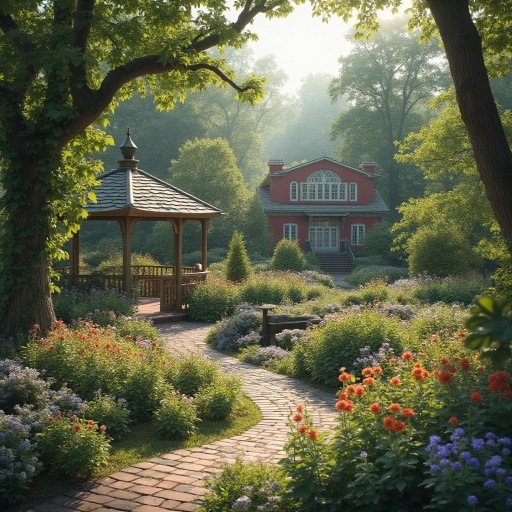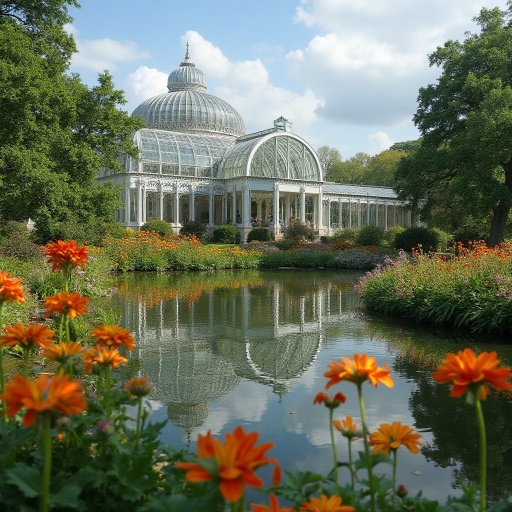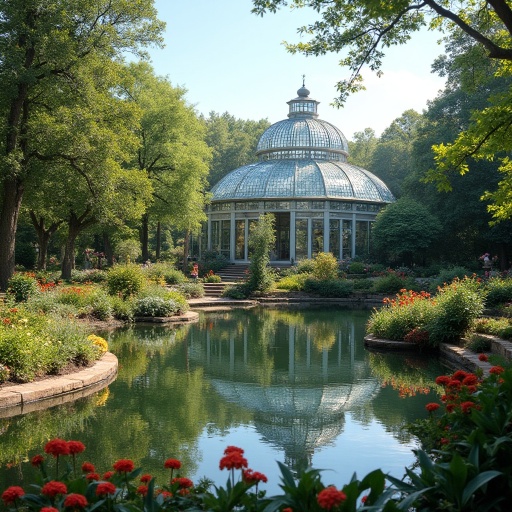Lewis Ginter Botanical Garden: Captivating Garden Design Ideas for Every Season

Did you know that visitors who spend just 20 minutes exploring thoughtfully designed gardens experience a 64% reduction in stress hormones? Lewis Ginter Botanical Garden in Virginia stands as living proof of how intentional garden design ideas can transform not only landscapes but also our well-being. This 50-acre botanical wonderland offers a treasure trove of landscape designs for enthusiasts and casual visitors alike, showcasing how thoughtful gardening landscaping can create spaces that inspire, educate, and rejuvenate throughout all four seasons.
Information About Lewis Ginter Botanical Garden
Lewis Ginter Botanical Garden offers an extraordinary blend of inspiring garden design and educational experiences:
- More than a dozen themed gardens showcasing diverse landscape designs from formal to naturalistic
- Four-season interest with carefully planned plantings that ensure visual appeal year-round
- Award-winning architecture integrated harmoniously with surrounding garden spaces
- Nationally recognized plant collections including roses, camellias, and native Virginia species
- Demonstration gardens providing practical garden design ideas adaptable to home landscapes
- Educational exhibits highlighting sustainable gardening practices and conservation initiatives
- Seasonal displays and installations that transform the garden throughout the year
The garden’s thoughtful landscaping designs provide endless inspiration for gardens of any size, from sprawling estates to intimate urban courtyards and container displays.
Timing
A typical visit to Lewis Ginter Botanical Garden requires approximately 2-4 hours to fully appreciate the diverse garden areas and absorb the wealth of garden design ideas on display. According to visitor data, most guests spend around 3 hours exploring the gardens, with additional time needed during special events or seasonal displays like the holiday GardenFest of Lights. The conservatory alone merits at least 30 minutes, while garden enthusiasts often spend 45 minutes in the Rose Garden during peak bloom. For maximum enjoyment, consider visiting on weekday mornings when crowds are typically smaller, allowing for unhurried exploration of the intricate landscaping designs.
Step-by-Step Guide to Exploring Lewis Ginter Botanical Garden
Step 1: Begin at the Visitor Center
Start your journey at the Georgian-style Robins Visitor Center, which houses the garden map, information desk, and garden shop. Take 15 minutes here to orient yourself and plan your route according to seasonal highlights and personal landscape design interests. Pro tip: Ask staff about current peak bloom areas and special displays to ensure you don’t miss any seasonal garden design showcases.
Step 2: Explore the Conservatory
The striking 11,000-square-foot conservatory serves as the garden’s crown jewel, featuring changing seasonal displays and permanent tropical collections. Note how the designers use varied heights, textures, and colors to create visual interest in the central palm house. The conservatory demonstrates how architectural elements can frame and enhance plant collections—a principle easily adaptable to home garden designs.
Step 3: Wander Through the Rose Garden
The classical design of the Rose Garden offers timeless landscape design lessons, with its symmetrical layout, central fountain, and thoughtful plant combinations. Observe how roses are integrated with companion plants to provide interest even when roses aren’t in bloom—a valuable technique for home gardening landscaping. The garden’s four quadrants demonstrate different rose types suitable for Virginia’s climate, providing practical ideas for home rose enthusiasts.
Step 4: Discover the Asian Valley
Venture into the Asian Valley to experience how cultural garden design principles can create tranquil, contemplative spaces. Pay attention to the careful use of stone, water elements, and pruning techniques that create a sense of balance and harmony. The strategic placement of plants to frame views and create journey-like experiences offers valuable landscaping design inspiration for creating garden “rooms” at home.
Step 5: Study the Children’s Garden
Even if you’re not visiting with children, the Lewis Ginter Children’s Garden provides innovative garden design ideas that engage all senses. Notice how the designers incorporate playful elements, edible plants, water features, and discovery spaces—concepts that can enliven any garden space. The varied textures, heights, and seasonal interest demonstrate how to create gardens that maintain appeal throughout the year.

Technical and Artistic Information
Garden History and Foundation
Lewis Ginter Botanical Garden was founded in 1984, fulfilling the vision of Grace Arents, who bequeathed the property for a botanical garden in memory of her uncle, prominent Richmond businessman Lewis Ginter. Located in Henrico County just minutes from downtown Richmond, Virginia (37.6173° N, 77.4693° W), the garden encompasses 50 acres of cultivated landscape and natural areas.
Climate and Resources
The garden experiences Virginia’s four-season climate with hot, humid summers and mild to cool winters (USDA Hardiness Zone 7a/7b). Annual precipitation averages 43 inches, fairly evenly distributed throughout the year. The garden utilizes sustainable water management systems including rain gardens, permeable surfaces, and efficient irrigation technologies. Lewis Ginter’s mission centers on connecting people through plants to improve communities, focusing on education, environmental stewardship, and creating beautiful spaces accessible to all.
Garden Varieties and Design Features
The garden comprises multiple distinctive spaces:
- Conservatory: A 11,000-square-foot glass dome housing tropical displays, seasonal exhibitions, and a central palm collection with 80-foot ceilings
- Rose Garden: A classical design featuring over 1,800 roses arranged in a quadrant pattern around a central fountain
- Asian Valley: A contemplative space featuring Japanese maples, Asian-inspired stonework, and a meandering stream
- Central Lawn: A grand open space framed by mature trees and seasonal borders
- Community Kitchen Garden: A productive space demonstrating edible landscaping designs that produce thousands of pounds of fresh produce for local food banks
- Healing Garden: A therapeutic landscape designed to engage all senses with aromatic plants, varied textures, and soothing sounds
- Flagler Garden: A formal garden featuring a central water feature and symmetrical plantings
- Children’s Garden: An interactive landscape with discovery stations, water play areas, and international-themed gardens
Distinctive Features
Lewis Ginter Botanical Garden stands out for its focus on four-season interest, ensuring the garden remains visually compelling year-round. The integration of classical and contemporary landscape designs throughout the property demonstrates how tradition and innovation can harmonize in garden settings. The garden’s nationally recognized education programs and community outreach initiatives extend its impact beyond the physical boundaries.
Infrastructure and Planning
The garden features:
- 1.5 miles of accessible paved pathways connecting all major garden areas
- Award-winning architecture including the conservatory and education center
- Strategic viewpoints and sight lines creating visual connections between garden rooms
- Comprehensive stormwater management systems incorporated as design features
- Energy-efficient facilities with sustainable landscape practices
Visitor Amenities
- Garden Shop offering plants, garden accessories, and nature-inspired gifts
- Two dining options: The Garden Café and Robins Tea House
- Library with over 5,000 horticultural reference materials
- Kelly Education Center with classrooms and exhibition space
- Multiple event venues including the Robins Room and Bloemendaal House
- Education classrooms and demonstration kitchen
- Accessible facilities throughout the grounds
- Rest areas and seating strategically placed throughout gardens
Events and Festivals
- Dominion Energy GardenFest of Lights (November-January)
- A Million Blooms spring celebration (April-June)
- Flowers After 5 summer concert series (Thursday evenings, May-September)
- Fall Plant Sale (September)
- Annual Rose Fest (May/June)
- Butterflies LIVE! exhibition (April-October)
- Seasonal workshops and symposia throughout the year
Access and Admission
The garden is open daily from 9am to 5pm, with extended hours for special events. General admission is $14 for adults, with discounts for seniors, children, and military personnel. Annual memberships offer unlimited visits and special privileges. The garden is closed on Thanksgiving Day, December 24, and December 25.
Management and Operations
Lewis Ginter Botanical Garden operates as a 501(c)(3) non-profit organization governed by a board of directors. A professional staff of approximately 60 full-time employees manages operations with support from more than 600 volunteers contributing over 40,000 hours annually. The horticulture team includes specialists in various plant collections, sustainable practices, and garden design.
Visitor Demographics
The garden welcomes approximately 400,000 visitors annually, with 80% from Virginia and the surrounding region. The remaining 20% includes tourists from across the United States and international visitors. School groups account for about 15% of total visitors, while special events like the GardenFest of Lights attract the highest attendance numbers. Community impact studies indicate the garden contributes approximately $9.9 million annually to the local economy.

Healthy Alternatives to Traditional Garden Visits
For those seeking to enhance their garden design experience:
- Participate in one of the garden’s hands-on workshops on sustainable landscaping designs
- Visit early morning for photography opportunities when light quality enhances garden features
- Explore the garden during different seasons to understand how landscape designs evolve throughout the year
- Consider nearby gardens like Maymont and the Virginia State Arboretum for comparative garden design study
- Join a guided thematic tour focusing on specific garden design elements like water features or native plantings
- Attend lectures and symposia featuring nationally recognized landscape designers and horticulturists
Introductory Suggestions for Garden Design Enthusiasts
To maximize inspiration from Lewis Ginter Botanical Garden:
- Bring a sketchbook to record garden design ideas and plant combinations that catch your eye
- Take close-up photos of successful plant groupings to reference for your own garden planning
- Make note of seasonal plantings that provide year-round interest in Virginia’s climate
- Pay attention to hardscape materials and how they complement plantings
- Observe how different garden areas transition from one to another through pathways and visual cues
- Study how water features are integrated into various landscape designs throughout the property
Common Mistakes to Avoid
When visiting botanical gardens for landscape design inspiration, many visitors make these common errors:
- Focusing only on current blooms rather than appreciating structural elements that provide year-round interest
- Failing to consider maintenance requirements when planning to replicate certain garden features
- Not adapting ideas to the scale of your home landscape (botanical garden designs often need downsizing)
- Overlooking the importance of proper plant placement based on growth habits and mature size
- Missing opportunities to learn from garden staff through scheduled tours and informal interactions
- Attempting to see everything in one visit rather than focusing on specific garden design concepts
Visitor Encouragement Tips
To fully engage with the garden’s design concepts:
- Join a seasonal guided tour for insights into design intentions and plant selections
- Participate in hands-on gardening workshops that teach practical landscape design skills
- Attend photography workshops that help capture garden design principles for later reference
- Consider volunteering to gain behind-the-scenes knowledge of garden maintenance techniques
- Visit during plant sales to purchase specimens featured in the garden’s landscape designs
- Follow the garden’s social media accounts for seasonal highlights and garden design tips
Conclusion
Lewis Ginter Botanical Garden offers endless garden design ideas that adapt beautifully to home landscapes. From formal rose gardens to naturalistic woodland settings, visitors discover practical inspiration for creating outdoor spaces that evolve with the seasons. The garden demonstrates how thoughtful plant selection, artistic arrangement, and sustainable practices create landscapes that nurture both nature and the human spirit.
Experience Lewis Ginter Botanical Garden for yourself and transform your own landscape with newfound inspiration. Share your visit impressions in our comments section or subscribe for seasonal garden design updates tailored to Virginia’s climate.

Frequently Asked Questions
What is the best season to visit Lewis Ginter Botanical Garden for design inspiration?
Each season offers unique design inspiration. Spring showcases bulbs and flowering trees, summer highlights the Rose Garden and perennial borders, fall features dramatic foliage color, and winter reveals structural elements and the holiday light display. For overall design principles, spring and fall typically offer the most dramatic visual impact.
Can I apply Lewis Ginter’s garden design ideas to my small urban yard?
Absolutely. While the scale differs, the design principles demonstrated at Lewis Ginter—such as creating garden rooms, using vertical elements, incorporating seasonal interest, and practicing thoughtful plant groupings—can be adapted to landscapes of any size, including container gardens for patios and balconies.
Does Lewis Ginter Botanical Garden offer design consultations for home gardeners?
While the garden doesn’t provide private consultations, they offer frequent workshops on garden design principles, plant selection, and sustainable practices. The demonstration gardens specifically showcase ideas adaptable to home landscapes, and staff horticulturists are available to answer questions during your visit.
How often do the garden displays change throughout the year?
The garden features both permanent landscape designs and rotating seasonal displays. The conservatory changes major displays five times yearly, while outdoor gardens evolve naturally with the seasons. Special installations and art exhibitions typically rotate quarterly, providing fresh design inspiration with each visit.
Are plants featured in Lewis Ginter Botanical Garden available for purchase?
Many plants showcased in the garden’s landscape designs are available during their spring and fall plant sales. Additionally, the Garden Shop maintains a curated selection of plants suitable for Virginia gardens, focusing on those that demonstrate superior performance in the garden’s displays.
